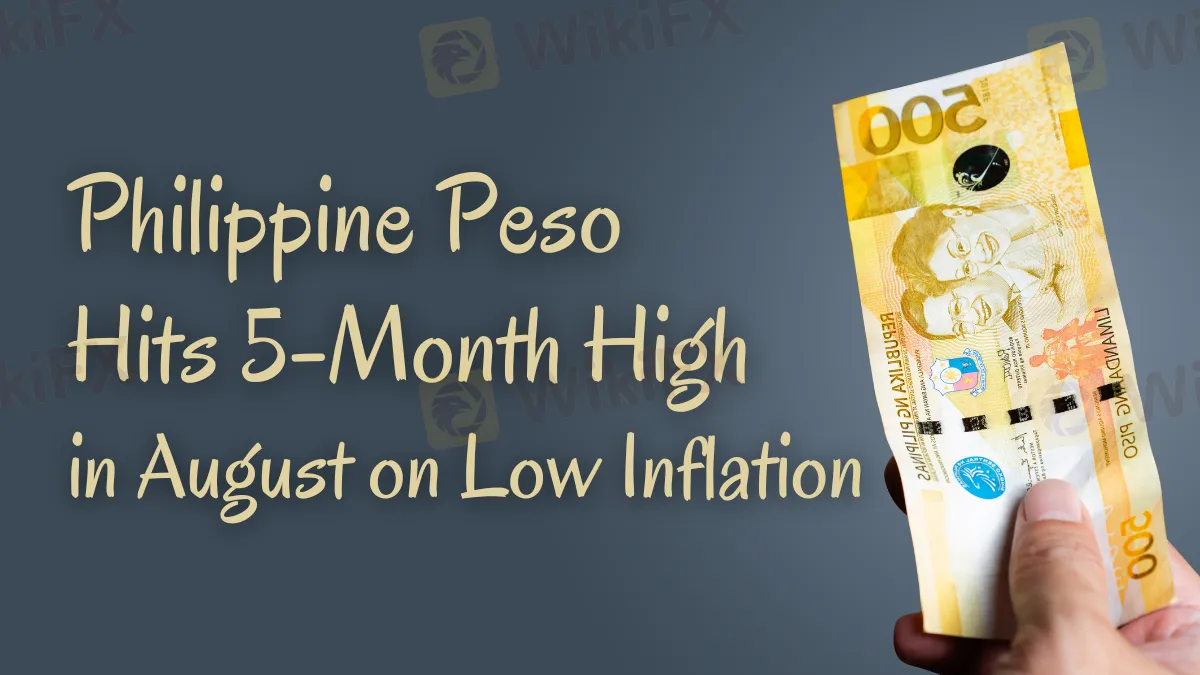简体中文
繁體中文
English
Pусский
日本語
ภาษาไทย
Tiếng Việt
Bahasa Indonesia
Español
हिन्दी
Filippiiniläinen
Français
Deutsch
Português
Türkçe
한국어
العربية
Philippine Peso Hits 5-Month High in August on Low Inflation
Abstract:The Philippine peso reached a 5-month high in August, closing at P56.111:$1, driven by lower inflation and regional currency trends.

Manila, Philippines — The Philippine peso rose to its highest level in five months at the end of August, boosted by a hopeful decline in inflation rates. On the month's last trading day, the peso rose 17.2 centavos versus the US dollar, ending at P56.111:$1 on Friday, up from P56.283:$1 on Thursday. This is the greatest performance of the local currency since March 21, 2024, when it ended at P56.03 per $1.
Central Bank's Inflation Forecast Spurs Peso Strength
The recent rise of the Philippine peso has been primarily attributable to the Bangko Sentral ng Pilipinas (BSP)'s estimate of reduced inflation in August. According to the BSP, the month's inflation rate is predicted to fall between 3.2% and 4%, a significant decrease from the 4.4% reported in July. This upbeat projection has encouraged confidence in investors and market players, leading to the peso's gain.
Michael Ricafort, chief economist of Rizal Commercial Banking Corp. (RCBC), said that the BSP's prediction was critical to the peso's upward trajectory. The central bank's inflation forecast predicts a gradual reduction of pricing pressures, which is good for the peso's value versus foreign currencies, notably the US dollar.
Regional Currency Movements and OFW Remittances Support the Peso
The recent performance of the Philippine peso mirrors wider regional trends. Ricafort remarked that the peso has been catching up to the greater gain witnessed in other ASEAN and Asian currencies over the last month. This tendency has been impacted by the rapid net appreciation of the Japanese yen versus the US dollar, which has repercussions on other regional currencies, notably the peso.

Furthermore, the seasonal rise in Overseas Filipino Workers (OFW) remittances, which normally peaks toward the start of the school year, has offered extra support to the peso. These payments were converted into pesos for tuition and other school-related expenditures, which boosted the local currency even more.
Outlook for the Philippine Peso Remains Positive
Looking forward, the peso is projected to continue rising. The currency has gained 2.8% after reaching a low of 57.28 per dollar in June. Ricafort expects the peso to rise further, reaching P56.5 per dollar by the end of the year.
This upbeat forecast is in sharp contrast to the scenario only a few weeks ago, when the peso was under substantial downward pressure. The BSP was forced to act to safeguard the currency at the time because inflation had suddenly risen in July. However, with inflation on the decline and the BSP likely to remain cautious on rate decreases, the peso's chances have greatly improved.
Philippine Peso Among Top Performers in Asia
The Philippine peso has recently emerged as one of Asia's best-performing currencies. Last week, it performed second best versus both the US dollar and the Japanese yen. This performance demonstrates the currency's resiliency in the face of recent dollar swings and the unwinding of carry bets backed by the yen.
The peso's strength will likely be impacted by inflation trends, remittance flows, and regional currency movements during the year. For the time being, the local currency's five-month high in August is a good indication of the Philippine economy.
Stay informed on the latest financial trends and how they impact you. Visit WikiFX News now for in-depth coverage and expert analysis on the Philippine peso's recent rise and more. Don't miss out!

Disclaimer:
The views in this article only represent the author's personal views, and do not constitute investment advice on this platform. This platform does not guarantee the accuracy, completeness and timeliness of the information in the article, and will not be liable for any loss caused by the use of or reliance on the information in the article.
Read more

The Hidden Checklist: Five Unconventional Steps to Vet Your Broker
Forex broker scams continue to evolve, employing new tactics to appear credible and mislead unsuspecting traders. Identifying these fraudulent schemes requires vigilance and strategies beyond the usual advice. Here are five effective methods to help traders assess the legitimacy of a forex broker and avoid potential pitfalls.

Doo Financial Obtains Licenses in BVI and Cayman Islands
Doo Financial, a subsidiary of Singapore-based Doo Group, has expanded its regulatory footprint by securing new offshore licenses from the British Virgin Islands Financial Services Commission (BVI FSC) and the Cayman Islands Monetary Authority (CIMA).

CFI’s New Initiative Aims to Promote Transparency in Trading
A new programme has been launched by CFI to address the growing need for transparency and awareness in online trading. Named “Trading Transparency+: Empowering Awareness and Clarity in Trading,” the initiative seeks to combat misinformation and equip individuals with resources to evaluate whether trading aligns with their financial goals and circumstances.

Malaysian-Thai Fraud Syndicate Dismantled, Millions in Losses Reported
The Royal Malaysia Police (PDRM) has received 26 reports concerning the Nicshare and CommonApps investment schemes, both linked to a major fraudulent syndicate led by a Malaysian citizen. The syndicate’s activities came to light following the arrest of its leader by Thai authorities on 16 December.
WikiFX Broker
Latest News
ASIC Sues Binance Australia Derivatives for Misclassifying Retail Clients
WikiFX Review: Is FxPro Reliable?
Malaysian-Thai Fraud Syndicate Dismantled, Millions in Losses Reported
Trading frauds topped the list of scams in India- Report Reveals
AIMS Broker Review
The Hidden Checklist: Five Unconventional Steps to Vet Your Broker
YAMARKETS' Jingle Bells Christmas Offer!
WikiFX Review: Something You Need to Know About Markets4you
Revolut Leads UK Neobanks in the Digital Banking Revolution
Fusion Markets: Safe Choice or Scam to Avoid?
Currency Calculator


